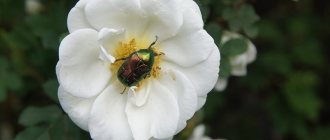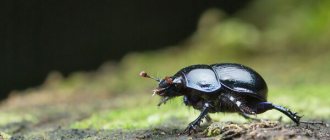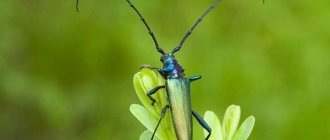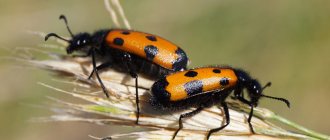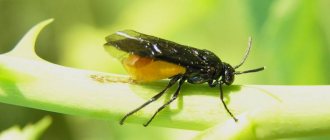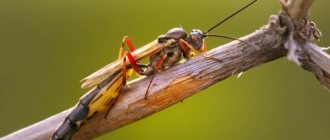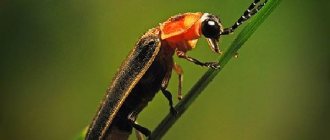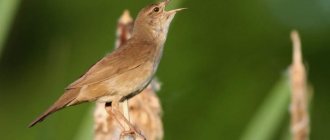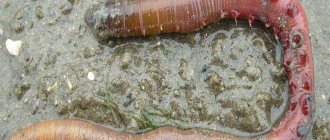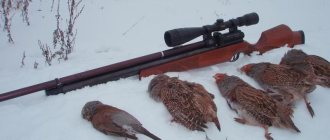Habitats and biology
Habitats are old broad-leaved and coniferous-deciduous forests with the participation of old oaks, the main or only food plant of the larvae [1]. Indications of development in some fruit trees [4-6] in the region have not been confirmed. The larva develops in the rotting cavity of old hollow-leaved deciduous trees, where it overwinters and pupates [6]. The beetles were recorded in June-July (possibly sometimes hatching at the end of summer and overwintering); active during the day, staying along heated forest edges and clearings, found in hollows and on tree trunks [1-3, 5]; According to the literature, they feed on flowing tree sap, less often on ripe fruits of pears and apple trees, as well as on the flowers of shrubs [6].
Offspring
Smooth bronze beetles lay their eggs in wood dust. The hatched larva begins to actively replenish nutrients by eating wood. The larva can reach up to 6 centimeters in length. The limbs of the larvae do not have hooks, so at the moment of danger it turns over on its back. The elytra of the larva are formed with the onset of the pupal phase. The smooth bronze cocoon has two layers:
- an outer layer with many small tubercles formed from wood dust;
- an even and smooth inner layer formed by the secretions of the larva itself.
At the pupal stage, the almost formed adult bronze beetle remains in the cocoon until the shell hardens. Due to the internal texture, the elytra of the smooth bronzer get the desired shape. Most individuals are formed from August to September. These beetles reproduce every three years.
Limiting factors and threats
Moderately stenotopic, but narrowly local and small in number, the species does not realize the apparently favorable opportunities for increasing its numbers, even if there is a potential food supply in the forests of the region. These factors suggest increased isolation of populations from the southern Tula abatis and almost complete isolation from most other areas. The decline in the number of the species is caused, first of all, by cutting down and death of old hollow oaks, suitable for the development of larvae, and, to a lesser extent, by fires and, possibly, anthropogenic pollution. In the long term, the slow self-renewal of oak is also unfavorable.
Methods of combating the bronze beetle
Are you afraid of bugs?
Not really
The bronze beetle is relatively harmful to agriculture, so no special methods have been developed to combat it directly.
You can attract a natural enemy - the Scolia wasp. Female wasps are immobilized while laying eggs. Wasp larvae feed on bronze beetle larvae.
One of the most common is the mechanical method. Early in the morning, beetles are collected from flowers by hand. Insects are placed in a jar with kerosene.
Chemicals
Chemicals are used in extreme cases. If the insect multiplies significantly, insecticides can be used carefully.
They use drugs that poison the Colorado potato beetle.
Spray the soil or introduce medications by watering. Treatment is carried out after sunset for the drug to start working. Apply:
- Decis;
- Spark;
- Lightning;
- Kinmiks.
Traditional methods
Among folk remedies, infusions with onions, horseradish, garlic, wormwood, tansy, and dandelion give good results. The following mixtures are particularly effective:
- horse celandine (300 g) is added to 1 liter of hot water. Leave for 2 days and spray, adding a teaspoon of grated soap;
- horse sorrel roots (30 g) are mixed with 1 liter of hot water and left for 4 hours. This solution is treated once every 5 days;
- wood ash is mixed with 5 liters of water and left for 48 hours. Add 1 tbsp. spoon of soap and spray.
Security measures taken and required
In the Tula region. There is 1 protected area (PP "Skalnye... near the village of Venev-Monastyr") with the habitat of the species, another 1 of them may be located at the PP "Aleksinsky Bor". It is necessary to limit economic activity in the habitats of the species through the creation of protected areas and public areas. It is necessary to create protected areas in the “Dacha Oka Forest” and “Dacha Upa Forest” massifs (Suvorovsky and Belevsky districts). Do not allow the killing of individuals; prohibit the cutting of old hollow oaks (or leaving their trunks to a height of 1.5-2 m) and the lighting of fires outside designated areas; limit cutting of remaining oak trees as much as possible; prohibit chemical treatments within a radius of at least 100 m from habitats; expand oak plantings. Investigate the possibility of introducing the species into suitable forest biogeocenoses.
Appearance
The smooth bronzer has an oval and convex body. A distinctive feature is the wing elytra, which do not rise. The hind wings open through special slits that are located on the side of the body. This structural feature allows bronzebacks to fly well. The head of these representatives is relatively small, very different from the width of the body and slightly tilted. Smooth bronzebacks have antennae that perform the function of searching for individuals for reproduction and food. The front legs are equipped with sharp spines, and the elytra are slightly compressed. The smooth bronzer is famous for its beautiful color, which has a bright green color with a characteristic metallic sheen. Some individuals may have a bluish-copper tint. The limbs are colored green with a blue tint.
Number and trends of its change
It is a very rare species in the region [1-3, 5, 7]. In the Tula region. 4 system-forming habitats are known in forests with areas ranging from several tens to hundreds of hectares, but coenopopulations and foci are located in individual extremely or very compact areas with groups of fodder trees; the state of all populations requires clarification. In each of them, mainly at the end of the twentieth century. from 1 to several beetles were noted, in one case also 11 larvae (10 beetles bred in the laboratory were released into the wild).
Lifestyle
Bronze cats lead an active lifestyle during daylight hours, especially loving sunny, bright days. Then they fly from place to place, moving at an impressive speed for such massive insects. It happens that a bronze bird does not have time to go around an obstacle it encounters, crashes into it and falls to the ground with a dull thud.
A bronze whale that falls from the sky usually lands on its back and flounders in the dust for a long time before it manages to regain its former balance. But in most cases, bronzes are very maneuverable, and rarely lose face. The beetle spends energy sparingly; it tries to choose flowers and inflorescences on which it can linger longer in order to both rest and eat.
In cloudy weather, they try not to get out of their shelters, which are provided by the leaves and roots of plants. Overnight stays are also most often arranged on the ground. The bronzes spend the winter months there in the ground. In different areas of the range, the activity of bronzes varies. In some places the flight lasts 2.5 months, in others 4.5 months, depending on the number of hot days.
Red Wiki of the Volgograd region
RedWiki is a free, unofficial guide to rare and protected species of fauna and flora of the Volgograd region.
The project has no formal relation to the official Red Book of the Volgograd Region (although it was initially based largely on the use of its openly published materials) and the government body responsible for maintaining it.
RedWiki materials are compiled by independent professional experts on a non-commercial basis, using both their own data and open sources available to them - which largely deprives the project of both bias and errors associated with the low qualifications of the authors. The mission of the RedWiki project - Red Wiki of the Volgograd Region - is to serve as a high-quality independent source of information about rare species of the Volgograd Region for any interested members of the public and professional community.
Despite its unofficial status, already at the time of its creation RedWiki is the most accessible, complete, reliable and up-to-date source of information about rare species of the Volgograd region of all existing ones
, including official publications of the Red Book. Of course, the resource administration will make every possible effort to ensure that this free directory becomes even more complete and reliable in the future.
RedWiki readers can use either the taxon catalog
, or
by searching the directory
to find the information they are interested in.
Information about official documents related to maintaining the Red Book of the Volgograd Region is located in the Documents
.
Information about the authors of the reference book is in the Authors
.
Editing of RedWiki is possible only by professional experts in the field of biodiversity of the Volgograd region at the invitation and consent of already registered authors. If you are such an expert and would like to take part in the work on the reference book, just contact any of the authors or the owner of the resource: your participation will be a great honor for the project. The rules and recommendations of the administration for authors can be found on the corresponding page
- reading it may also be useful for readers to understand the general principles of compiling the directory.
All names of taxa in RedWiki and their taxonomic position are given in strict accordance with the current lists of species officially approved by the administration of the Volgograd region
(if available in them).
Even if they seem strange, erroneous or absurd (and at the time of creation of the directory this is often the case) - all questions about this should be directed to the persons who compiled and approved the lists from the Documents section, and not to the project participants. The reference book in front of the reader is in this regard only a mirror of official documents, and asking the mirror questions about the shortcomings of the original is, as is known, somewhat unpopular. The authors of the directory can only be responsible for the accuracy of the information about taxa provided by them personally, and only with their reputation
.
Otherwise, the directory data is provided to the reader “as is” - without guarantees and without any participation in their subsequent independent use
, no matter what consequences it may lead to. At the same time, the administration and authors of the resource, of course, will be glad to receive any objective feedback and constructive comments that help improve the project.
RedWiki is a free reference book, but its freedom does not mean permissiveness and irresponsibility. All reference materials are provided under the terms of the Creative Commons “Attribution-NonCommercial-ShareAlike” license
(“Attribution - Non-Commercial Use - Same Terms”).
All license terms can be found in detail here
. In short, the RedWiki licensing terms mean the following:
- The RedWiki Content may be used by anyone for any purpose
(including modifications or derivative works) as long as there
is no financial or monetary compensation involved
. - All users of RedWiki materials are required to clearly indicate their author
, and also to publish all works based on RedWiki materials
only under identical conditions
. - RedWiki materials may not be used by anyone for material or monetary reward under any circumstances
.
Such purposes include, for example, work on any commercial projects, including research funded from any sources other than the personal funds of their performers, as well as the preparation of any printed and electronic materials (in particular, official publications of the Red Books) for material remuneration. Of course, this restriction cannot apply to the open sources themselves used by the authors of RedWiki, and only applies to materials prepared and provided by the authors personally
. In addition, the publication of materials in RedWiki, of course, in no way implies any alienation of the rights of their authors, and the author himself can use the information presented in RedWiki simultaneously, independently of this directory, in any other way anywhere, including under any agreement - both those that generate income for the author and those that are free of charge. So anyone who wants to use RedWiki materials for commercial purposes or on terms other than the project license can contact their direct authors to conclude a separate agreement with them “outside the walls” of the directory, otherwise both the author of the material and the owner of the resource will have legal grounds for prosecution of all persons associated with the use of these materials in violation of the project license.
Genus Goliathus
Or goliath beetles. The largest representatives of the bronze subfamily. The weight of the beetle can reach 100 g, and the body size is 11.6 cm.
Large green beetles of the species Mecynorrhina torquata are not much smaller in size than Goliathus regius. The length of the male can reach 8.5 cm.
The main color of the representatives of the genus is black with white spots. Sometimes there is more white in color than black.
Goliaths are inhabitants of Central and Southeast Africa. They are not found in Russia. If such a beetle is found on Russian territory, it means that it escaped from someone’s terrarium.
Bronzovka beetle
many faces. It is a genus of insects, not a separate species. All bronze beetles are lamellar, that is, they are relatives of cockchafers and belong to the order Coleoptera. The scientific name of the beetle is cetonia. The word is Latin. Translation: “metal beetle.”
Food preferences
The harm this insect causes becomes clear from what the bronzeback eats.
Pest food preferences:
- flowers (especially light ones);
- young fruits;
- ovary of plants or fruits;
- first leaves.
The beetles completely eat up the stamens and pistils, so sexual reproduction of seed plants becomes impossible, and the yield sharply decreases. It is not surprising that gardeners and gardeners are looking for effective ways to deal with bronzes.
If the bronze fly gets into the house, then its food becomes indoor plants.
Other ground insect pests
Most often, the roots of garden and berry crops suffer from underground pests, which eat various insects or their larvae living in the soil:
- centipedes - small individuals, breed in compost heaps, eat flower bulbs, strawberry fruits, strong population growth is observed at high humidity;
- earthworms and earthworms - although they are beneficial by digging up the top layer of soil, they have a negative effect on the adhesion of roots and soil, which can cause plants to be pulled underground;
- cutworm caterpillars (winter and exclamation) - in the spring months they live underground and feed on the roots of vegetable crops, preferring cabbage, carrots and seedlings of ornamental flowers, they also gnaw leaves and root vegetables;
- wireworm larvae (striped or bread nutcracker) - attack vegetable crops, strawberry and strawberry plantings, eating small roots and larger roots, damaging root crops and flower bulbs;
- May beetle larvae - live for several years in the soil, feeding on underground parts of plants (vegetables, shrubs and fruit trees);
- springtails - white jumping insects settle in the ground near garden and house plants.
Garden pests
